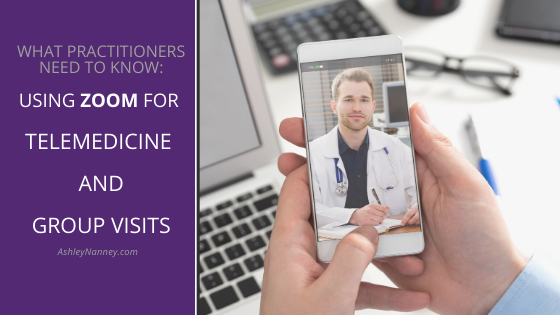With the rise in telemedicine and online group visits, our practitioners are asking about Zoom and other conferencing options.
Platforms like Zoom, Skype, Microsoft Team and others are becoming familiar to more and more patients. According to Statista, Zoom was the most downloaded app in the U.S. with 3.2 million new users, the week of March 26th – April 1st alone.
As telemedicine and the Zoom platform gains popularity, so have concerns about privacy and security. Unwelcome intrusion and accusations about Zoom sharing data with Facebook are valid concerns. So, how does this affect you? I have compiled some resources for you to consider as you move forward in offering telemedicine and group visits.
Here are the most common questions I hear from practitioners:
Is conducting a Zoom visit HIPAA-compliant?
It is always prudent to familiarize yourself with HIPAA compliance and any state regulations. With the rise in telemedicine, it is getting easier to find information on this topic. Here are a few articles you might find helpful:
- Zoom’s position paper on HIPAA Compliance: https://zoom.us/docs/doc/Zoom-hipaa.pdf
- Notification of Enforcement Discretion for Telehealth Remote Communications During the COVID-19 Nationwide Public Health Emergency: https://www.hhs.gov/hipaa/for-professionals/special-topics/emergency-preparedness/notification-enforcement-discretion-telehealth/index.html
This is where I tell you I am not a lawyer (couldn’t even play one on TV well). Please do not construe any information I share as legal advice.
I have heard of ZoomBombing. Should I be concerned?
Recently, video conference hackers have started to pop up in unprotected meetings posting offensive material or taking over the meeting. This is known as “ZoomBombing.” To prevent ZoomBombing disruptions, create a password and share the meeting information only with the participants you want to attend. Don’t post your password publicly. Zoom also offers a “waiting room” feature you can enable. The waiting room feature requires patients and guests to wait for your approval before joining the call. Finally, you can lock a meeting while it’s underway and remove participants, if necessary.
What Zoom plan should I sign up for?
It depends on the length of your group visits. Some practitioners find that the free plan is all they need, while others pay $14.99/month. The free plan offers up to 100 participants and unlimited 1:1 and group visits, so it will work for most group visits. The main issue with the free plan is that group visits will automatically end after 40 minutes, whether or not you are finished with the visit. Since most group visits are over 40 minutes, the $14.99/month plan may be a better option for your practice.
How should I set up the group visit call?
Have you seen sample Zoom calls where everyone’s picture shows up like the opening sequence of The Brady Bunch tv show? This popular format is better for more casual groups. To help your patients feel safe asking questions, you may want to set up a different format. To set up a call that matches the needs of your patients, you may want to block them from using their camera and have their comments and questions come to you rather than the whole group. Try different settings to determine what works best for you. Here is a link to the Zoom Meeting Control options: https://support.zoom.us/hc/en-us/articles/115005759423-Managing-participants-in-a-meeting
How many patients should attend a group visit?
It depends entirely on the format of your visit. If it is more of a lecture format, you may not need to limit the number of patients and guest attendees. If you are conducting a Q&A group visit, in my experience, more participants can result in less conversation. Participants may feel uncomfortable speaking in front of a virtual audience. The social cues in a virtual setting are not the same as an in-person group visit. If you do not have your settings adjusted, there’s the risk of multiple people talking at the same time. There can also be lags in the audio portion of your visit that can cause interruptions or people talking over one another.
Should I mute group visit participants?
Yes, or ask them to turn off their microphones at a minimum. Background noises of barking dogs, children, shuffling papers, etc. can be very distracting for other participants.
Should I conduct virtual group visits from my home or office?
Either is fine, but keep a few things in mind:
- Background noise should be kept to a minimum. If you choose to conduct your visit from home, put the dog outside, send the family for a drive and set up a quiet space that works for you.
- Pay attention to EVERYTHING in the background of your video. Less is more. Avoid backgrounds that include political or sensitive topics that might be interpreted as offensive.
- Pay attention to what you are physically doing while on camera, wear a solid color, pay attention to how you look and avoid touching your hair and face as much as possible.
What if I do not have a suitable backdrop?
If you have a messy backdrop or don’t want people focused on the books on your bookshelf, Zoom does offer some customizable backdrops. Just be aware that they can affect your connectivity.
What if I do not like how I look on camera?
I get it! I am camera shy too. Luckily, Zoom has a feature to touch up your appearance with a softer focus that can smooth your skin’s appearance for an airbrushed look. Be brave, play with the settings and find an option that works for you. Most people are conducting meetings this way, so no one is expecting a flawless face or perfect hair. The message you have to share is more important than how you look on camera.
If you have a question about making this work for your practice, we are happy to help!




